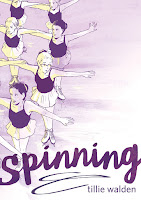There’s a lovely tradition in the high school I work at where teachers to post the title of the book they’re currently reading on their classroom door. I was puttering around last Friday, packing up before Winter Break, and I changed my sign over to show my latest read, Kindra Neely’s graphic novel Numb to This: Memoir of a Mass Shooting. A student who has struggled in my class asked me about it, and then wanted to see the book, and then asked when is it gonna be on the bookshelf? I was reading a library copy, but you can bet I placed an order for this one as soon as I had a spare moment. In my opinion, there’s nothing better than finding a book (the right one, the one they choose!) for that student who needs it. And on top of that, this book is a must-read – an important, shattering story from a gun violence survivor – a chance to listen to someone share what that aftermath looks and feels like.
Kindra Neely never expected it to happen to her. No one does. Sure, she’d sometimes been close to gun violence, like when the house down the street from her childhood home in Texas was targeted in a drive-by shooting. But now she lived in Oregon, where she spent her time swimming in rivers with friends or attending classes at the bucolic Umpqua Community College.
And then, one day, it happened: a mass shooting shattered her college campus. Over the span of a few minutes, on October 1, 2015, eight students and a professor lost their lives. And suddenly, Kindra became a survivor. This empathetic and ultimately hopeful graphic memoir recounts Kindra’s journey forward from those few minutes that changed everything.
It wasn’t easy. Every time Kindra took a step toward peace and wholeness, a new mass shooting devastated her again. Las Vegas. Parkland. She was hopeless at times, feeling as if no one was listening. Not even at the worldwide demonstration March for Our Lives. But finally, Kindra learned that—for her—the path toward hope wound through art, helping others, and sharing her story.
Kindra Neely survived the Umpqua Community College mass shooting in Oregon in 2015, and her beautiful, poignant, and searing memoir of the years after is absolutely required reading. There’s some background and context-setting, but the majority of Neely’s book focuses on the day of the shooting and what happened next: how she reacted in the short- and long-term, the impact of PTSD on her life, and the reality of a suicide attempt: all while presenting a front to the world. In the 300 pages of this debut graphic novel, Neely lays herself bare for a purpose, saying “I…went looking for a book about how to deal with the aftermath of a shooting, but I couldn’t find one. Maybe I could make a book to show people like me that they aren’t alone, or that their feelings are normal.”
Neely’s story is not just one of trauma, though it does deal with that. It keeps the tension between hope (she survived, she keeps surviving, she finds meaning in making art & helping others) and realism (there are bad days full of fear, depression is very real, and some people are uncomfortable around those who are open about their trauma). The pacing and scene changes are also telegraphed well and keep the “journey” of Neely’s life (narrative) moving. It is also heartwarming to see the real-life friends come alongside Neely in tough moments, and vice versa, even though no one is without flaws (except maybe Neely’s mom). The supportive, healthy relationships and networks from her life are excellent guides for young readers to follow, internalize, and model in their own lives.
Pacing and storytelling in the graphic novel format rely so much on the art… and I just want to say that Neely’s art is fabulous. I would have no idea that this was a debut – her style and linework are polished, modern, and evocative. The emotion bleeds through the pages, and while this volume is in full color, I think Neely’s neat linework and focus on facial expressions would work in any color palette. There’s doesn’t seem to be a predominant or overarching color theme, but teals and purples show up quite a bit in scenes set in Oregon, and harsh yellows and reds during moments of stress and trauma. Overt symbolism of dragonflies appears throughout (and is explained directly in the text).
Overall, Neely’s story and art are indistinguishable/inseparable – and the result, a compulsively-readable volume, allows her to be vulnerable in the service of helping others. Numb to This is heart-wrenching and incisive and belongs in every high school library in the country.
Recommended for: high school nonfiction collections, and anyone ages 14+ who has been touched by a mass shooting in some way (at this point, everyone in the US).


























